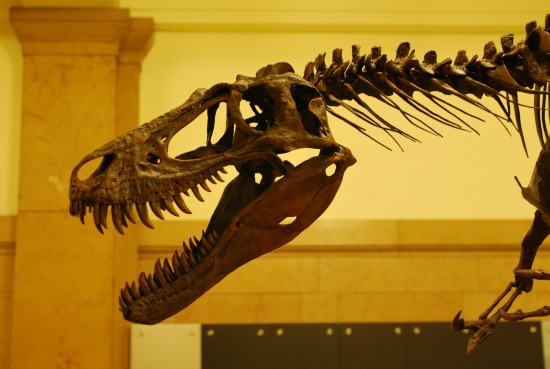The Awkwardness of Tyrant Teens
Adult T. rex had the most powerful bite of any creature to walk the earth, but they had to grow into that destructive power
![]()

A cast of the juvenile Tyrannosaurus rex “Jane” at the Carnegie Museum of Natural History. Photo by the author.
Tyrannosaurus rex is a perfectly-named dinosaur. There is no better title for a forty-foot long, knife-toothed predator that was the biggest carnivore in its ecosystem and, sadly, one of the last non-avian dinosaurs. For over a century, the tyrant has been the quintessential dinosaur, and the fantastic nature of the creature has even ensnared paleontologists. No non-avian dinosaur has been as celebrated or well-studied, and all that attention continues to yield unexpected discoveries about how this dinosaur actually lived. For one thing, T. rex had the most formidable bite of any creature to walk the earth.
In the new issue of Smithsonian magazine, I have a short profile on the dinosaur’s devastating bite. The piece is based on a Biology Letters study published earlier this year by Karl Bates of the University of Liverpool and Peter Falkingham of the University of Manchester, both in England, that estimated that the bite force of an adult T. rex could be up to 12,800 pounds. That’s about the weight of the dinosaur itself slamming down into prey, and this powerful bite was made possible by massive muscle attachments between the tyrants lower jaw and the expanded rear portion of the skull. (The giant prehistoric shark Carcharocles megalodon had a more powerful bite–estimated at about 41,000 pounds–but T. rex remains the winner among fully terrestrial animals.)
But T. rex wasn’t born with such destructive power. Only the huge adult tyrannosaurs were capable of the upper limits Bates and Falkingham calculated. When the scientists estimated the bite force of a juvenile T. rex, based on the specimen famously known as “Jane,” they found that the teenage tyrant’s bite force topped out at a measly 880 pounds. Young T. rex had to grow into the formidable powers their species is so famous for.
The difference between the weak bites of the juveniles and the crushing bites of adult T. rex hint at something tyrannosaur experts such as Thomas Holtz have been saying for years. Young T. rex were not identical to adults–they were more slender, their skulls were shallower and they possessed a slightly higher count of more blade-like teeth. (Some paleontologists claim that this body type isn’t representative of juvenile T. rex but another genus of tiny tyrant called “Nanotyrannus.” Despite the controversy over this point, though, the defenders of “Nanotyrannus” have never made a solid case for the dinosaur.) In other words, young T. rex were not living and hunting the same way as their parents. Teenage T. rex, such as Jane, were small-prey specialists who had teeth and jaws best suited for rending flesh rather than delivering crushing bites.
Young T. rex may have lived a separate existence from their parents. Rather than going after the same kinds of prey, which would have put them in direct competition with their parents, they specialized in smaller fare until they were large enough to snatch unwary Triceratops and Edmontosaurus. Among ecologists, this is known as “niche partitioning.” The phenomenon wasn’t unique to T. rex. Two years ago, John Whitlock and colleagues described the skull of a juvenile Diplodocus–one of the hefty, long-necked sauropods from the American West’s 150-million-year-old Morrison Formation. Whereas adult Diplodocus skulls had a squared-off muzzle, adapted to grazing on carpets of low-lying ferns, the juvenile had a rounded snout better-suited to browsing. Perhaps, the researchers hypothesized, fast-growing juvenile Diplodocus had to be picky about the kinds of food they ate to adequately fuel their bodies, and so they were browsers rather than grazers.
As paleontologists uncover new juvenile dinosaur specimens and re-examine those that have already been found, they’re finding that young dinosaurs were not miniature versions of their parents. Dinosaurs changed drastically between birth and adulthood and may have even undergone dramatic transformations late in life. T. rex is just but one symbol of this new understanding–a dinosaur that transformed from an awkward-looking, fuzzy teen to one of the most monstrous predators to have ever evolved.
/https://tf-cmsv2-smithsonianmag-media.s3.amazonaws.com/accounts/headshot/RileyBlack.png)
/https://tf-cmsv2-smithsonianmag-media.s3.amazonaws.com/accounts/headshot/RileyBlack.png)